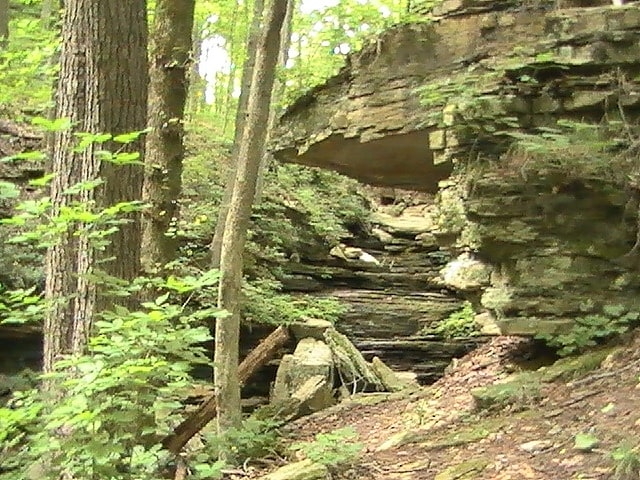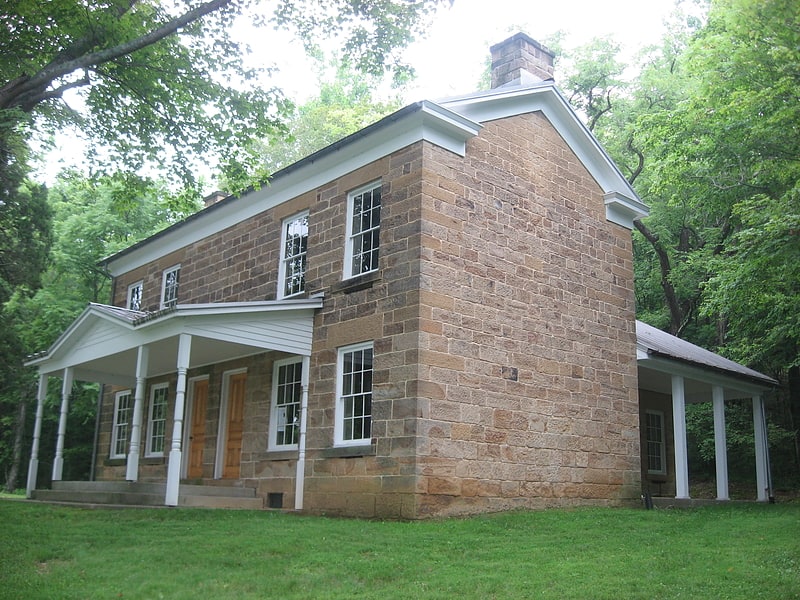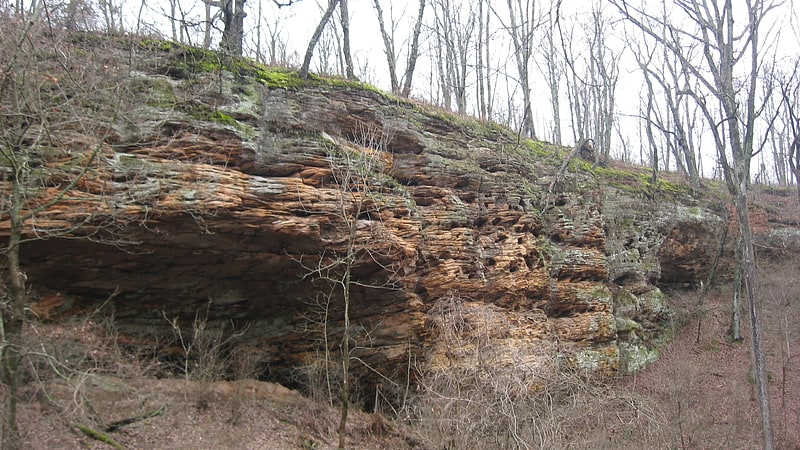Discover 7 hidden attractions, cool sights, and unusual things to do in Hoosier National Forest (United States). Don't miss out on these must-see attractions: Buzzard Roost Trail, Hickory Ridge Fire Tower, and Jacob Rickenbaugh House. Also, be sure to include Rockhouse Cliffs Rockshelters in your itinerary.
Below, you can find the list of the most amazing places you should visit in Hoosier National Forest (Indiana).
Table of Contents
Buzzard Roost Trail

The Buzzard Roost Trail is a hiking trail in Southern Indiana, north of the community of Magnet, Indiana. It is part of the Hoosier National Forest and is maintained by the USDA Forest Service.
The trail begins on a bluff overlooking the Ohio River. From there a steep trail ascends through a hardwood forest to a rocky stream that runs into the river with waterfalls and large sandstone outcrops. The trail is approximately 0.8 miles (1.3 km) long. The overlook area has primitive camping and picnic facilities. it has multiple trails with many small caves.[1]
Address: Buzzard Roost Rd, 47520 Magnet
Hickory Ridge Fire Tower

The Hickory Ridge Fire Tower is a Fire lookout tower located in the Charles C. Deam Wilderness Area. It is an Aermotors type lookout tower.
Construction of the tower began in 1936 under the auspices of the Civilian Conservation Corps. It is constructed of steel with a seven foot square 'cab' on the top where the lookout was posted with various equipment including an alidade device used to help locate the location of fire outbreaks. As constructed, the tower included 123 wooden steps to provide access to the cab Following a refurbishment of the tower, the wooden steps were replaced. Today, there are 133 steel steps. Originally there was a cabin or guard station, a latrine, and a garage built on the site. All but the tower have now been removed.
The tower was staffed during periods of high fire danger for approximately 40 years. During such times, a small team of fire fighters was stationed at the base of the tower to respond to fire reports as needed. Some peak times saw as many as four to five fires per day. One of these fires, one of the largest on record for the area, came within half a mile (800 meters) of the tower before it was stopped. The tower never endured a fire, though it has been struck by lightning.
Manning of the tower ceased in the late 1970s as the need for the tower had been replaced by other technologies. The tower was one of eight located in the Hoosier National Forest, but is now the only tower remaining. It was added to the National Historic Lookout Register in October 1990, the first such tower in Indiana to be listed.
The tower remains open to the public throughout the year as an observation tower.[2]
Address: Tower Ridge Rd, Hoosier National Forest
Jacob Rickenbaugh House

Jacob Rickenbaugh House is a historic home located in Hoosier National Forest, Oil Township, Perry County, Indiana. It was built in 1874, and is a two-story, "T"-plan dwelling constructed of ashlar sandstone blocks in the late Greek Revival style. It has a low pitched gable roof and side porches on each side of the rear ell. From 1870 to 1961, its parlor housed the Celina Post Office. It was acquired by the United States Forest Service in 1968.
It was listed on the National Register of Historic Places in 1984.
The house has been restored and is open regularly for self-guided tours in the spring-fall season.[3]
Rockhouse Cliffs Rockshelters

The Rockhouse Cliffs Rockshelters are a pair of rockshelters in the far southern region of the U.S. state of Indiana. Located amid broken terrain in the Hoosier National Forest, the shelters may have been inhabited for more than ten thousand years by peoples ranging from the Early Archaic period until the twentieth century. As a result of their extensive occupation and their remote location, they are important and well-preserved archaeological sites and have been named a historic site.[4]
Browning Hill

Browning Hill, known locally as Browning Mountain, is, at 928 feet tall, the 53rd highest peak in Indiana. Located in Brown County, near the town of Story, the hill is partly in Hoosier National Forest, and is designated a special management area by the United States Forest Service due to the "relatively undisturbed" old-growth forest that covers it.
The hill has acquired an air of mystery. It looms over the ghost town of Elkinsville and is topped by a limestone "field of boulders", giving rise to its nickname, "Indiana's Stonehenge." Various explanations are given for how the stones got there, such as it being a Native American site for ceremonies or a cabin's foundation, but according to a naturalist, it is most probable that early settlers quarried the stones and then left them behind when they moved on to other locations.[5]
Potts Creek Rockshelter

Historical landmark in Crawford County, Indiana. The Potts Creek Rockshelter Archeological Site, within Hoosier National Forest in Crawford County, Indiana, was a camp for Archaic, Woodland, and Paleo-Indian Indians. It is currently unoccupied by habitation.
It was listed on the National Register of Historic Places in 1987.[6]
Second principal meridian

The second principal meridian, or Paoli Meridian, coincides with 86° 28′ of longitude west from Greenwich, starts from a point two and one half miles west of the confluence of the Little Blue and Ohio rivers, runs north to the northern boundary of Indiana, and, with the base line in latitude 38° 28′ 20″, governs the surveys in Indiana and part of those in Illinois.[7]